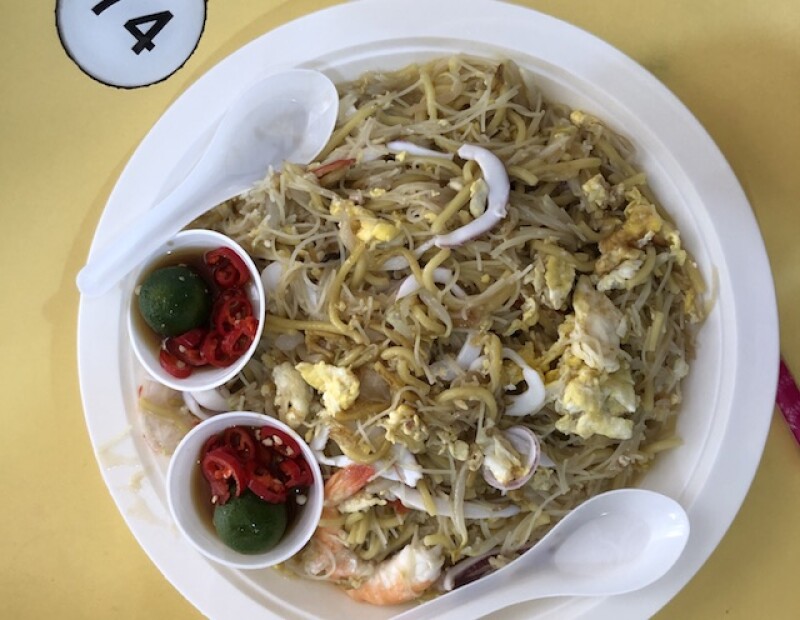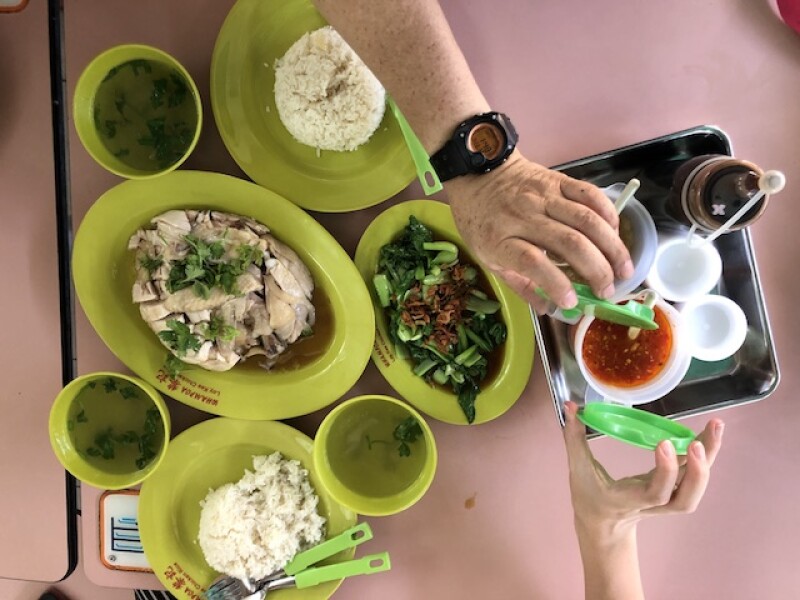I’m hunched over a pale heap of poached chicken and rice in steamy Singapore, sweating and speechless.
Sitting at a plastic table in an open-air hawker center, I’ve just taken a bite of the chicken—moist and rich, surrounded by a thick layer of fat and skin. And I’ve also sampled the rice–deceptively plain in its whiteness—but cooked in a heavy chicken stock with shallots, garlic, ginger, sesame oil, and a hint of butter.
My dining companion seems to know exactly what I want to say as my eyes roll into the back of my head with pleasure.
“My god, that chicken is so soft, and the warmth of your mouth turns that jelly back into fat, and it just hijacks your palate,” says KF Seetoh, one of the city state’s most famous advocates of Singaporean hawker food, who has dedicated his life to its research and preservation.
He adds that the price of my sensory nirvana cost me $3.
“That’s not even a tip where you come from,” he says.
I nod as I load my spoon with the next bite of rice, over which Seetoh has enthusiastically drizzled gooey caramelized soy sauce and a dollop of chili.

Whampoa Drive Food Centre, Singapore
Photo by Constance Yeo
“There’s magic and secrets in there, which I’m learning every day,” he says. “The [hawkers] are not schooled in any culinary arts, and some of the techniques are not formally recorded. Like how a guy would dip and dunk a chicken 90 times just to poach it, and then drown it in ice water so that he can jellify the fats.”
Seetoh and I are at the Whampoa Drive Food Centre, one of the 114 open-air hawker centers in Singapore that house more than 6,000 stalls in the city state. I’ve known about Seetoh for years: I’ve followed him through his Makansutra books and street food tours and have seen him numerous times on the various travel shows of his dear friend, the late Anthony Bourdain, a longtime devotee of Singaporean street food. Seetoh has introduced the complex and multicultural tapestry of flavors and stories of Singaporean street food to everyone from Jean Georges Vongerichten to the distinguished late New York Times journalist Johnny Apple. I looked him up on a recent trip to my onetime home—where I spent many nights as a teenager in the local food courts, getting into trouble with friends while washing down the culinary delicacies of the hawker centers with Tiger Beer—to bond with him over this rich food culture. Most importantly, I wanted to talk to Seetoh about the future of Singaporean hawker food—which many consider the heart and soul of Singapore—and which, according to Seetoh, is hanging in the balance.

The owners of Loy Kee Chicken Rice & Porridge stand in front of their stall in Whampoa Drive Food Centre
Photo by Jennifer Flowers
Hawker centers started about a half a century ago, soon after Singapore became a sovereign city state. With a careful eye on sanitation, the government wanted to regulate the numerous food vendors that feed Singapore’s population. Today, dozens of cultures and subcultures are represented, and dishes range from Malaysian nasi lemak to British food such as fish and chips, now sold in hawker centers by Hainan Chinese immigrants who once cooked in the homes of U.K. expats. It’s the most democratizing food tradition too—people from all walks of life eat at hawker centers and obsess over its flavors (two hawker stalls even have Michelin stars). Yet techniques—such as the elaborate process of jellying chicken fat—are surprisingly elaborate for their low price tag. And according to Seetoh, many hawker stall owners start prepping their food as many as four to six hours before their first customer arrives at 7 a.m.
Seetoh is telling me all of this at the Old Airport Road Food Centre, another popular lunch spot dating to 1972. We sit at a circular table and survey the vendors—whose tiny stalls surrounding us are lined up neatly in rows—as we dine on hokkien mee from Nam Sing Hokkien Fried Mee. As I tuck into this magical noodle dish, made with a rich shrimp stock whose flavor is absorbed by the noodles, Seetoh launches into a story about the Ng brothers, who have served—and mastered—this one dish out of their tiny stall for close to 50 years.

KF Seetoh presenting a plate of “char kway teow” noodles, Old Airport Road Food Centre
Photo by Jennifer Flowers
“It’s not about food. It’s about food culture,” he says. “It’s a culinary umbilical cord that connects them to their fathers’, their mothers’, their grandparents’ food, which relates back to the story of Singapore. Migrants came to Singapore, no hope, no job, no tomorrow, no money. And they said, ‘I gotta sell food to my people.’”
I realize quickly that I’m standing inside a modern-day museum. Every vendor and their delicacies are a direct living connection to the stories of the families who own the stalls and to the larger story of Singapore. How could this incredible piece of living history be at risk of dying out?
Some efforts have been made, with mixed results, in a social enterprise model aimed at revitalizing hawker food stalls. It’s also common these days to see headlines about hip young Singaporeans ditching their corporate lives and opting to preserve their parents’ street food legacy instead. Seetoh told me of a banking analyst with Malay roots who now hawks chee cheong fan noodles. But that’s more of an exception to the rule.
“For every two young hawkers who open, 10 are saying bye-bye,” says Seetoh. “Everybody has a degree, everybody is looking to be the next big dot com or app thing. Who’s going to stand and sweat in that little 10 by 10 kitchen jail and hawk food that people love but underappreciate, at $3 a plate?”
Seetoh was a vocal advocate and advisor when Singapore recently submitted its hawker culture nomination for induction into the UNESCO Intangible Cultural Heritage of Humanity in 2020. And his World Street Food Congress, which he founded in in Singapore 2013 to preserve, protect, and record the world’s great street food cultures, was attended by heavy hitters, including Bourdain and Noma cofounder Claus Meyer.
He’s hopeful that the potential UNESCO designation will shed more light on the uniqueness of the world’s great street food traditions—and possibly even create more government support and much-needed entrepreneurial innovation around preserving and continuing their legacy. Currently hawker food falls under Singapore’s National Environment Agency, but Seetoh is advocating for a dedicated team that focuses on hawker food, which has become one of Singapore’s top attractions.
“The trick about enjoying Singapore food culture is don’t just come here and eat. Know the backstory,” he says. “You see this Silk Road of food and it makes dining here so much more interesting.”
Check out our Instagram highlights for a tour of some of Singapore’s best street food stalls with KF Seetoh. And if your travels take you to Singapore soon, read on for a list of the places we ate, or book a tour with Seetoh and his team at Makansutra.

Char kway teow in Singapore’s Old Airport Road Food Centre
Photo by Jennifer Flowers
Char Kway Teow
What it is: A noodle dish with roots in Malaysia, made with dark soy sauce, chili, prawns, and shrimp paste among other Southeast Asian ingredients. The coup de grâce: it’s fried at extra high heat in pork fat, giving the noodles a smoky wok flavor that will haunt your dreams.
Where we ate it: Dong Ji Fried Kway Teow, Old Airport Road Food Centre

Hokkien mee from Nam Sing Hokkien Fried Mee, Old Airport Road Food Centre
Photo by Jennifer Flowers
Hokkien Mee
What it is: With roots in China’s Hokkien province, hokkien mee consists of noodles cooked in an extra rich shrimp broth. Talk about an umami bomb in your mouth.
Where we ate it: Nam Sing Hokkien Fried Mee (Hougang), Stall 01-32, Old Airport Road Food Centre

Curry puffs from Wang Wang Crispy Curry Puff, Old Airport Road Food Centre
Photo by Jennifer Flowers
Curry Puffs
What it is: Flaky pastry shell around savory flavors inside that range from the curry puff to black pepper chicken—all made by hand at the hawker stall.
Where we ate it: Wang Wang Crispy Curry Puff, Stall #01-126, Old Airport Road Food Centre

Hainanese chicken rice from Loy Kee Chicken Rice, Whampoa Drive Food Centre
Photo by Jennifer Flowers
Hainanese Chicken Rice
What it is: Created by Singaporean immigrants from Hainan, an island off the southern coast of China, this dish is now beloved across Southeast Asia. The deceptively simple looking dish consists of poached chicken and seasoned rice, usually accompanied by a chicken broth. Locals like to mix caramelized soy sauce and chili into the rice,and dip the chicken in a chili-ginger concoction.
Where we ate it: Loy Kee Chicken Rice, #01-49/50, Whampoa Drive Food Centre; Nan Xiang Chicken Rice, Whampoa

“Chendol” from Nyonya Chendol, Whampoa Drive Food Centre
Photo by Constance Yeo
Chendol
What it is: A Malaysian dessert consisting of a shaved ice base, with coconut milk, green pandan jelly noodles, beans, and palm sugar. When the Singaporean heat gets you down, this is the ultimate pick-me-up.
Where we ate it: Nyonya Chendol, stall #01-17, Whampoa Drive Food Centre
To book a tour with Makansutra, go to Makansutra.com.











